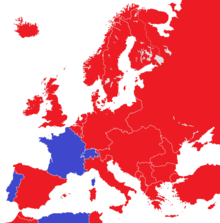|
We All Fall Down |
- By TomStar81
By October 1918, with the loss of the Russian Empire and the Kingdom of Bulgaria to internal strife and military failures, the gates on the dam of political revolution had begun to lift slightly, allowing those peoples formerly bound by monarchical governments to push for a greater degree of control in their nations. Ordinarily, such an action would have amounted to suicide in Europe up until the early 20th century, but the war had drawn off much of the military forces that would otherwise be needed to crush protesters and uprisings, and this in turn left many nations ripe for revolution or independence from their parent empire.
Monarchy in Europe is not a new concept, history suggests that it had existed in some for or another going back to 1,200-3,000 BCE. These early monarchies were among tribes that inhabited the region before strong forces such as the Greeks managed to subjugate the smaller forces and claimed leadership over them. This was accelerated by the rise of Rome, first in its Republican form and later in its Imperial form, which managed to put the vast majority of nations in what we would call Western Europe under its influence for centuries. The Roman Empire's mixed government vested power in the Roman Emperor, but retained the Roman Senate as an instrument of power in the government by which those elected could speak on behalf of their people. Rome's collapse and the subsequent "Dark Ages" also heralded a new form of monarchy in Europe in which those who came to the throne blended the religion of Christianity with politics to create the concept of the Divine right of Kings, which justified total or near-total rule by the monarch as part of God's will and therefore absolving the king from any theoretical obligation to answer to his people.
As the Middle Ages dawned, the monarchical political system would find itself uniquely positioned to take advantage of the socioeconomic concept of feudalism, which followed the collapse of the Roman Empire and gathered much strength among the governments and peoples of the day. Feudalism in Europe ran at its peak periods between about the 7th century and the 15th century, during which time aristocracy and monarchies across Europe reigned with near absolutely power in a time when the Christian Church was suppressing most of the scientific and technological fields along with competing ideologues of government as being harmful to God.
By the time of the 14th and 15th centuries, geo-political forces at work elsewhere began to assert their influence in European affairs beginning with the Crusades, which had helped weaken the feudal system in Europe by sending able-bodied persons to fight against the Muslims in the Holy Land, and a growing interest in scientific and technological fields that had been suppressed by the church to greater or lesser extents for some time. These developments followed on the heels of the Great Famine of 1315–17 and the Black Death, and occurred at a time when the church was dealing with the fallout from the East–West Schism of 1054. At the same time, various kings and emperors were attempting to reclaim territory given to nobles to rule in early centuries under feudalism. In the midst of these upheavals in Europe came a man named Christopher Columbus, whose 1492 rediscovery of the Americas marked a new age of exploration for Europe. With the crowns eager to learn more about this territory and to secure land for trade and colonization, a rush to stake a claim in the New World began as many European kingdoms began to send there parties overseas to scout.
By the time of World War I, most of these European kingdoms had laid claim to the lands in the Americas, Africa, and to lesser extents the Asia-Pacific region. These intercontinental empires had allowed the European nations to pull in vast amounts of personnel and supplies in the ensuing conflict, but by 1918 many of these monarchies were militarily and economically exhausted, and the impending end of World War I was beginning to affect those reigning over kingdoms and empires in the form of both socialist and republic sentiments on the home front as well as a "to the victory goes the spoils" mindset in the war front.
Beginning with the collapse of the Russian Empire in 1917, several European kingdoms and empires would be disbanded as citizen actions and political treaties began to take their toll. By the end of 1918, the Austria-Hungary Empire, Kingdom of Württemberg, Kingdom of Bavaria, Kingdom of Saxony, Kingdom of Serbia, Kingdom of Prussia, and the German Empire had all collapsed as the end of the war and republican/socialist sentiment took its toll in nations exhausted by four years of war. Some nations, like Serbia, would merge into other kingdoms in Europe (in Serbia's case, the Kingdom of Yugoslavia); others like the German Empire would outright cease to exist and instead evolve into republics.
While a number of monarchies in Europe would collapse as a result of World War I, and later World War II, there are still a few remaining royal houses that weathered the conflicts. Of these surviving monarchies the most famous is probably that of the United Kingdom, where Queen Elizabeth II continues to enjoy popular support, laying claim to the titles of longest-serving British monarch and oldest reigning monarch among the surviving European kingdoms.
|



